KHEN SHISH
☰
☰
x
- ← I DIDN’T HAVE THE HEART TO WAKE YOU
- Naomi Aviv
- 2013
She shows up to our meeting with a flower again, offering it with a delicate gesture and a benevolent smile. One flower with a long stem. A Gerbera. Thirteen years ago, when she started exhibiting drawings and collages, she could fill entire walls with basic gestures, with automatic, diligent line drawings, topped by one or several petals. Sometimes that petal became an eye. She made lots of eye-flowers with stems. The same flower, if shown upside down, became a light bulb dangling from a wire, like the lonely light bulbs in the American artist Philip Guston's paintings. At times the light bulb became a black and melancholic sun or a frustrated corm. The bulb would develop into a bird, an insect, a kind of beetle, which would metamorphose in its turn into a kind of spider with multiple arms and tentacles. These graphic motifs, kinds of symbols, seemed to take shape spontaneously. Her papers were pasted directly onto the walls of Hagar Gallery in Jaffa, covering them from top to bottom. Already back then her symbolic scribbles were seen as expressive, essential, temperamental and legitimate expressions. The legitimacy for these ideograms came from precedents such as Raffi Lavie, Aviva Uri and Moshe Gershuni.
Now, as she unfolds the large canvases – diptychs and triptychs and one pentaptych – measuring in metres and about to be exhibited for the first time at Gordon Gallery, she herself is overtaken. It seems she has completed the transition from drawing to painting. The works, layered with spontaneous touches in a limited palette, have acquired an authoritative air. Painting-painting. An energetic dialectic of covering and erasing; an intimate and free dialogue which seemingly refuses to be locked in a cage of words or of distinct figures; black or golden paint applied directly from the container, by hand and by brush, with a line and with fingertip taps. It was Clement Greenberg who in the 1950s defined such painting as an “event”, training our gazes to follow the traces left by body gestures on the canvas: painting as a collection of testimonies to the painterly act itself, its force or its tenderness, its stutter or its eloquence, its length or its punctiliousness. In the eighties this type of art, which peaked in the fifties, engendered a burst of vibrant neo-expressionist activity, with raw, primitivist forms and emotional, symbolist contents, which looked into the historical and mythical depth and used it as a launch pad to embarkon a fresh painterly adventure. Many artists breathed life into certain aspects of the original abstract expressionism. The neo-expressionist energy came from Europe – Germany, Italy – with mythological artists such as Kiefer and Richter, and the transavantgarde of Clemente, Chia, Cucchi and Paladino, and settled in New York. Israel also saw the development of a strong local-international version of romantic and emotional neo-expressionist painting, for example in the painting of Tsibi Geva. Julian Schnabel, the disputed star of the expressionist return to painting, claimed that the neo-expressionism of the eighties actually emerged in opposition to Greenbergian abstraction. According to him, the new painting offered an “art that was less elitist, less hermetic. Its subject matter was more overtly related to life.” Nonchalant and unpretentious graphic rawness, and a constant movement between the controlled and the uncontrolled received emblematic expression in the art of Jean-Michel Basquiat, which has remained as contemporary as it was at the moment of its birth. “It’s abstract and it’s over the top,” Basquiat summed it up.
Roberta Smith, the New York Times art critic, recently published a piece in which she tried to delineate the state of contemporary painting. Her principal claim is that painters today are freer in regards to painting than ever before. She suggests that today, the encounter between the representational and the abstract seems vital and natural. Painting in her view is in a moment of dazzling balance between the representational and the abstract. The painters who have emerged in the last decade enjoy artistic freedom. They paint what they want in a wide variety of styles, materials and methods.
THE MAKING OF KHEN SHISH
Khen Shish is a ceremonial artist. She wakes up early in the morning, washes the floor in her apartment, washes her hair and only then, as fresh as a daisy, turns to the canvas. More often than not she jumps out of bed impatiently even before sunrise and quickly cleans and gets cleaned so she can go and look at the struggle and wrestling animating the painting on which she was working the day before. Since we are not dealing with painting made from observation of nature, landscape or an object, and since we are not dealing with an enactment of a vision that has taken shape earlier in her mind, and since we are not dealing with any kind of preplanning or prior knowledge, no wonder she is excited and curious about the moment she will look, for the first time, at her creation.
At the looking stage the distance between her and the outside viewer is almost erased. The painting surprises her as much as any observer. Surprise is fundamental to this kind of intuitive painting. As is the abstract approach. No doubt the same signs, images or symbols that recur again and again as part of the artist’s handwriting may encourage an analytical or symbolist reading, which is far from obligatory and sometimes even absurd. Some readers may remember how in the last decade of his life Raffi Lavie abandoned his representations of the secular prickly pear cactus, and re-baptised it as a Geranium – a half-wild half-cultivated scented plant – and with this essential change his paintings started yielding new, symbolist readings! It was very strange. What was even stranger was that he did not reject such readings, as he did earlier in his career, but allowed them to undermine and contest early readings which had established his status as the leader of a Tel Aviv school – fresh, materially scarce, clear of phraseology and symbols.
An important, amusing and confusing moment is the moment after “what came out came out”, because she must “paint for the painting”, especially when she has an exhibition coming up and a fixed opening date. On the canvas, initially covered with thick black paint applied by hand, crude forms take shape in the strong light of the lamp. She moulds them until they become abstract painterly elements, the aforementioned ideograms, in the usual palette identified with her. Now comes the gallerist or curator or friend. She pulls out the paintings one by one and immediately tells the viewer what he is seeing and what she has painted (inadvertently, in an inertial, automatic, somewhat Dadaistic swoop, it should be remembered).
She unfolds for example the nocturnal pentaptych (a painting composed of five panels), painted with strong hand and brush movements, with lots of coal black, white, red, green. The pentaptych measures 5 metres in width and 2 metres in height. A typical expressive abstract. Looks like an “explosion” of red fireworks in the night sky. Without waiting for the viewer’s reaction, and knowing intuitively that the human mind likes stories, she immediately suggests some childish narrative, in fact she makes up a “story”. This is a very important stage in her creative process and it stands almost in contradiction to the rather accidental character of the painting. “Here on the side it came out as a green bamboo with a bird’s head on it. This is a galaxy with tons of stars, eyes, endless sky with rising chariots. The painting stands on bird’s legs, and there is a light bulb, smoke, x’s, eyes as huge as boats, autumn leaves strewn on the white ground and a kind of vase in which floats a red heart”.
She pulls out another diptych. Two 2x2 metre canvases. A kind of childish fantasy of the Garden of Eden. “Here it came out as a couple, a male and a female. She has tears with smoke. His body is a line with a bird’s leg and a pile of leaves. She has a breast; it’s as if the breast is spurting something. Hair and a hand. In her hand she’s holding a flower. He is also holding a flower. From his flower hangs a light bulb and below there is some dark-coloured fruit. One is red on green, poisonous, and between them there is a kind of golden tree and lots of layers of transparent white.” Another painting: “A pregnant female bird and it has fins that slide into the fire. Opposite it there is a male bird holding a transparent egg and sprouting a stem and some leaves. Between them there is fire. It’s white. It’s a golden jungle. The dry green looks like gold. The female is standing. The male is bending forward”.
And then comes a very powerful painting, teeming with hand and brush touches: a black tree with roots and a treetop. The treetop is painted like a large eye that burns in orange and red. The inner frame is gilded and is designed, according to the artist, “to delimit, glorify and elevate the painting”.
THE BAPTISM CEREMONY, THE LYRICAL STAGE
After the narrative stage comes another verbal stage: The titles. The ceremony itself looks like this: all the new paintings are lined up against the walls of the living room which serves as her studio. Now she pulls out of the computer a page with lines upon lines of (unlike the painting) articulate and polished titles, which she has collected from a manipulative reading of literature and poetry. The titles - mostly romantic, are far more finished, normative, poetic, than the paintings. She devotes a moment or two to the titles, debating which painting should be matched with which line from the sheet she has printed out listing the readymade names. The link between the title and the work is loose rather than illustrative, and the relation between the quite random title and the spontaneous painting is lyrical, airy and playful. In successful cases the title coupled with the work tugs at your heartstrings. The baptising ceremony is extremely important to her. She once explained it: “So they don’t remain orphans, poor things, so they don’t walk around nameless.”
It is actually the polished title, usually unconnected to the painting, which takes the painting back to its initial abstract stage.
Thus the magnificent pentaptych with the nocturnal landscape is given the readymade title: Littering the Landscape with a Broken Heart. The broken heart resonates with the heart in the title of the exhibition as a whole, “I Didn’t Have the Heart to Wake You,” which has also been extracted from the pre-prepared list. But many hearts have been broken in her paintings in the last thirteen years.
The painting that looks like a fantasy of Adam and Eve in the Garden of Eden is given the name: An Exotic Cat and A Real Viper Snake. The painting with the pregnant bird whose fin catches fire is called: It Wasn’t the Street that I Loved, But You. The big tree with the mushroom-like top shaped like a large burning eye receives the name: Hundreds of Miles of Pain. The painting with the self-important bird opposite the large eye is called: Song, Bird. Another painting featuring an eye with a burning pupil, a fish’s fin, a bird’s head, a deer’s horn, feathers, leaves, smoke and some x’s is called: I Was In Love Big Time. The painting featuring a kind of bird-of-paradise with a huge red beak, pink wings and a broken heart is called: Her Heart is in the East. A kind of figure in profile turning its back on a black creature, a bird’s leg and some curling smoke is called Hope You Burn.
NO SMOKE WITHOUT FIRE
The smoke curls which have frequently risen from figures or houses in her paintings are joined for the first time by fire and by the orange colour. Here and there she ignites it in red orange and black but on the whole she takes care not to let the fire consume the image or the picture. It is a toned-down fire, at times even frozen or whitened, yet it is still stoked in the title which seems to have been unleashed from the bottom of her heart, “I Wish You Burn.” It would not be surprising to find interpretations based on esoteric philosophies, and those who wish to replace the mystery in her painting with mysticism (the letters that make up her first name in Hebrew are already an acronym of Occult Wisdom), will also find ample scope to pursue. Shish herself, a native of the magical town of Safed and a person of faith by her own definition, may actually encourage a mystical reading.
THE BIG HEART
It is easy to love Khen Shish. It is easy to fall in love with the quasi-decorative freshness of her works. It is easy to surrender to the beautiful titles and to the whole quasi-childish process involved in the name-giving. It is easy to protect her, and to encourage her. And she has indeed received some grants and prizes that have left her no choice but to become totally devoted to art, fatally sabotaging her simple childhood dream of becoming an arts and crafts teacher. And still we might wonder how a collection of seemingly familiar gestures and scribbles have become canonical works of art. The enormous diptych featured in the Permanent Collection of Israeli Art exhibition, her pair of large vultures, which was chosen by Ellen Ginton, the Israeli collection’s curator, concluded that year’s purchases by the Tel Aviv Museum. So she is in the Tel Aviv Museum’s collection of Israeli art and in numerous private collections, and in general her painterly sensibilities have been warmly embraced.
“I Didn’t Have the Heart to Wake You ” is the name of the new exhibition by Khen Shish, an Israeli soul artist who paints the way a bird sings. Does her painting soak up power from the history of Western art? Of course. Does her painting spring up from the foundations of Israeli painting? Certainly. Should we juxtapose her painting with the work of Dganit Berest or Michal Naaman, the way she was juxtaposed in the past with Lea Nikel at the Ashdod Art Museum and at Beit Mani in Tel Aviv? Not necessarily. Khen Shish is not a descendent of the avant-garde principality which was here in the conceptual seventies, nor is she a typical pupil of Yitzhak Livneh’s neo-expressionist school. It does not mean that the works of Naaman or Berest or Getter do not also possess an impulsive and spontaneous dimension whose meaning sometimes takes years to become clear, but Shish’s painting is ideogrammatic and of a different kind, close in spirit to the calligraphic drawing of Dorchin and Aviva Uri, and hereafter continuing to accrue power from the Italian Transavantgarde and from the whole return-to-painting trend that developed at the end of the seventies and the beginning of the eighties.
For many years the Modernist action or gesture painting has been asking to be registered also as an act of giving, of generosity. Khen Shish is the right person to achieve this combination of a painterly gesture that comes from the whole body rather than just the hand, and an act of showering the viewer with abundance. Her new painting is more mature, rich and plentiful: a pair of birds, eyes as big as a boat, pregnancy, giant tears, flower, heart, fruit, leaves, and lots of gold. Those who are looking for a new model of art in this hyper-utilitarian age should look for it in the (always surprising) gestures of generosity. Maybe it would be right to call it retrograde. An echo of those offerings , that human beings used to present to the gods in order to placate them. For perhaps every work of art is the offshoot of that ancient ritual. That is, art originates from the cosmic need to perform a gesture of giving, however formed or stylised, carried by a bighearted movement, from the body to the world. For before everything else, the artist still goes into the studio to create something priceless.
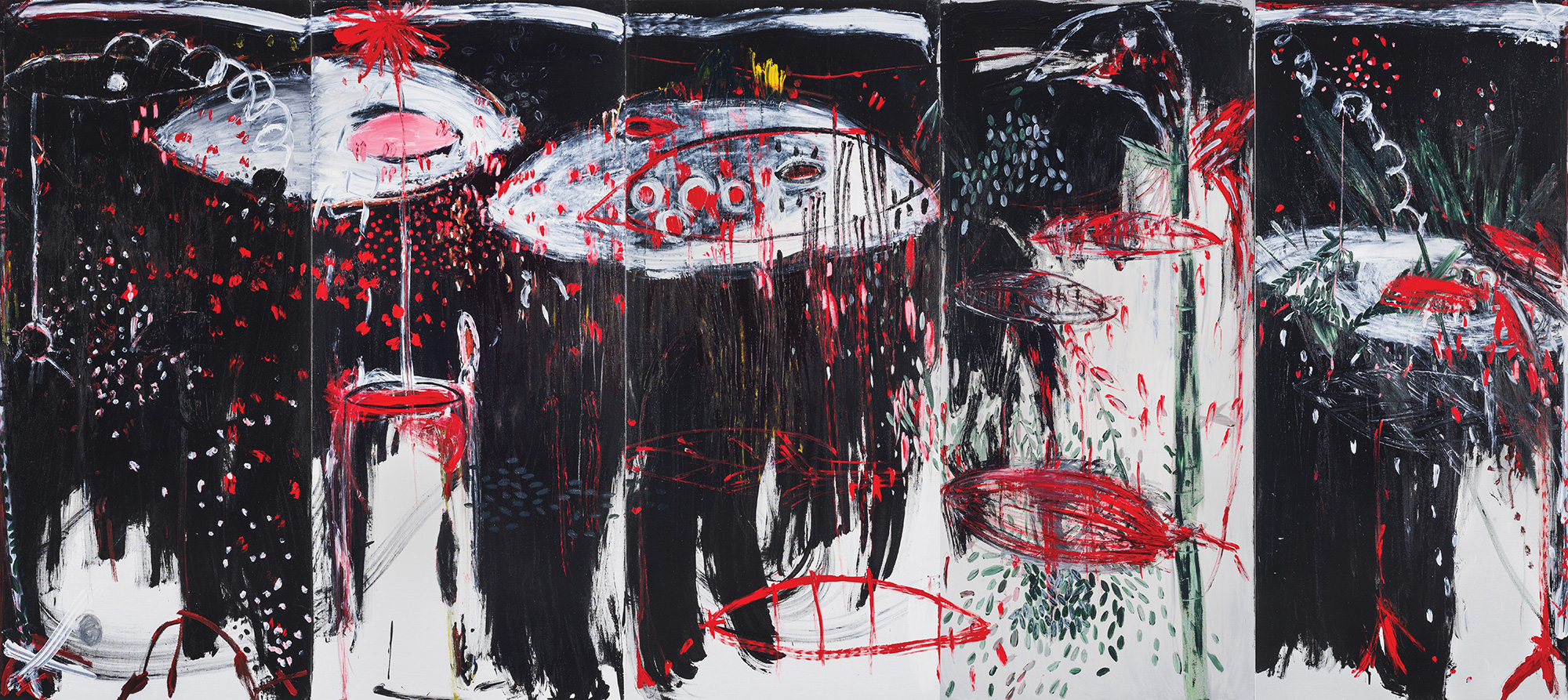
Littering the landscape with a broken heart, 2013, pentaptych, acrylic on canvas, 200x450
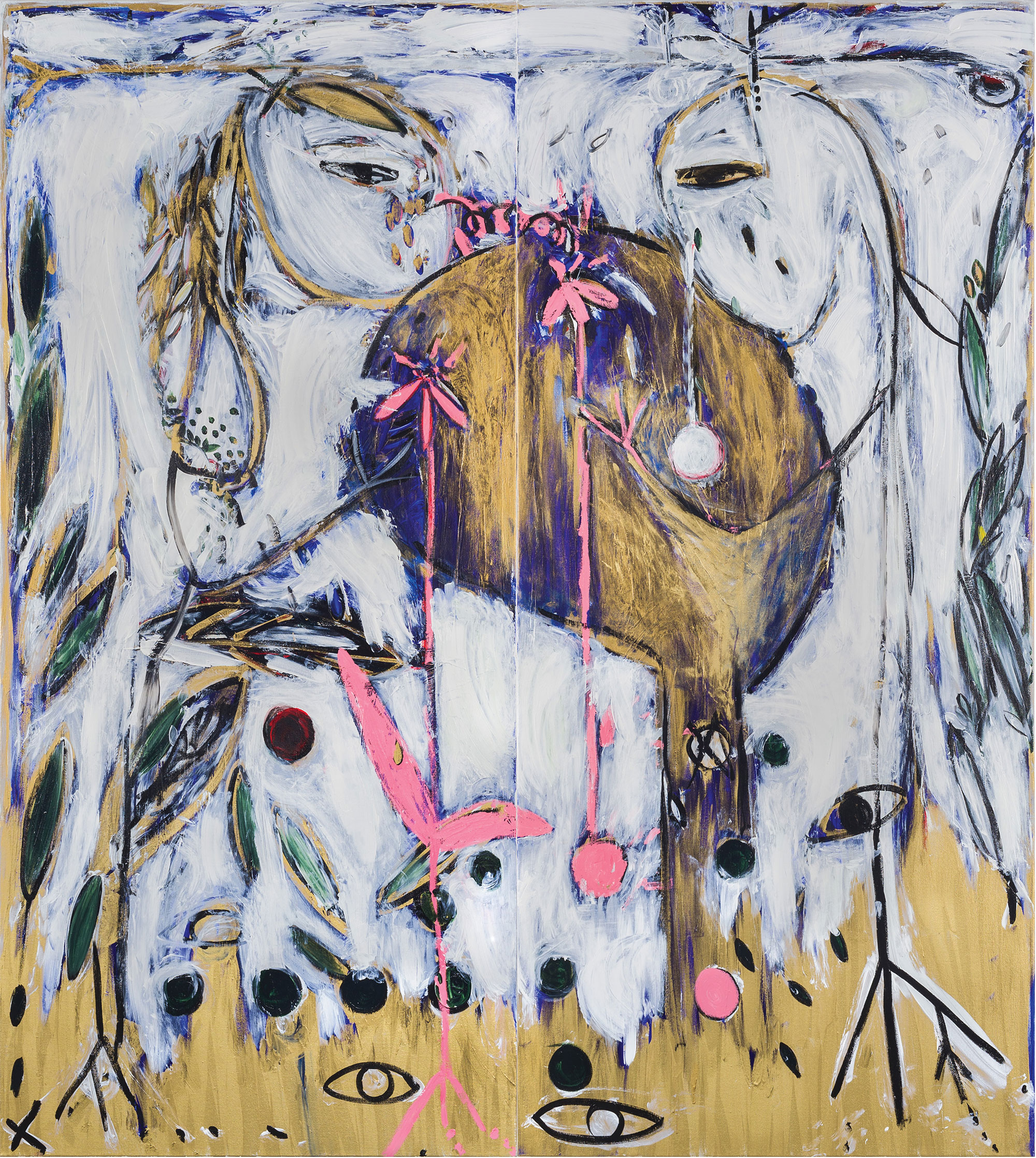
Exotic Kitten and Serious Viper, 2013, dipptych acrylic on canvas_200x180
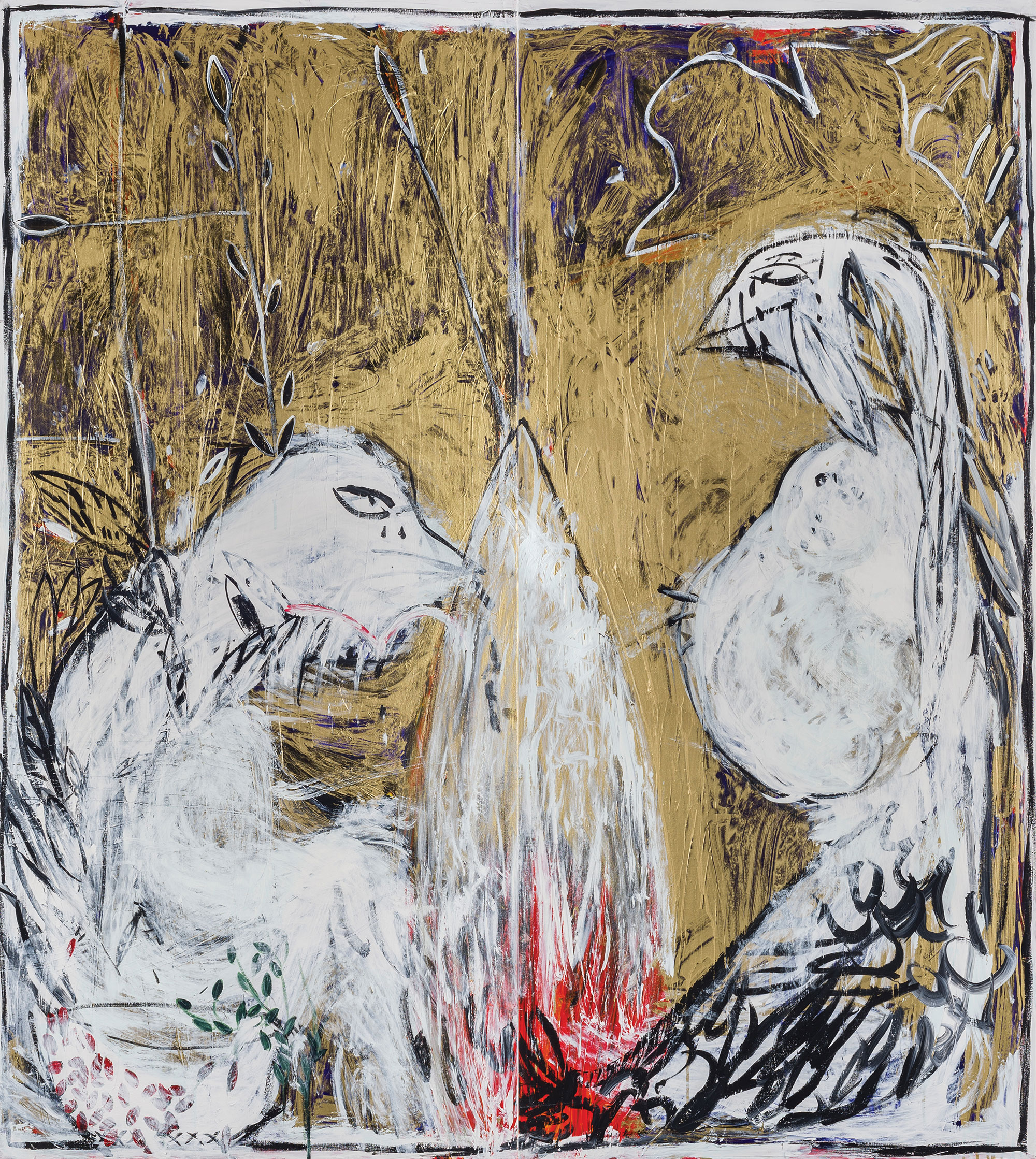
It Wasn’t the Street that I Loved, It was You, dyptich, 2013, acrylic on canvas, 200x180
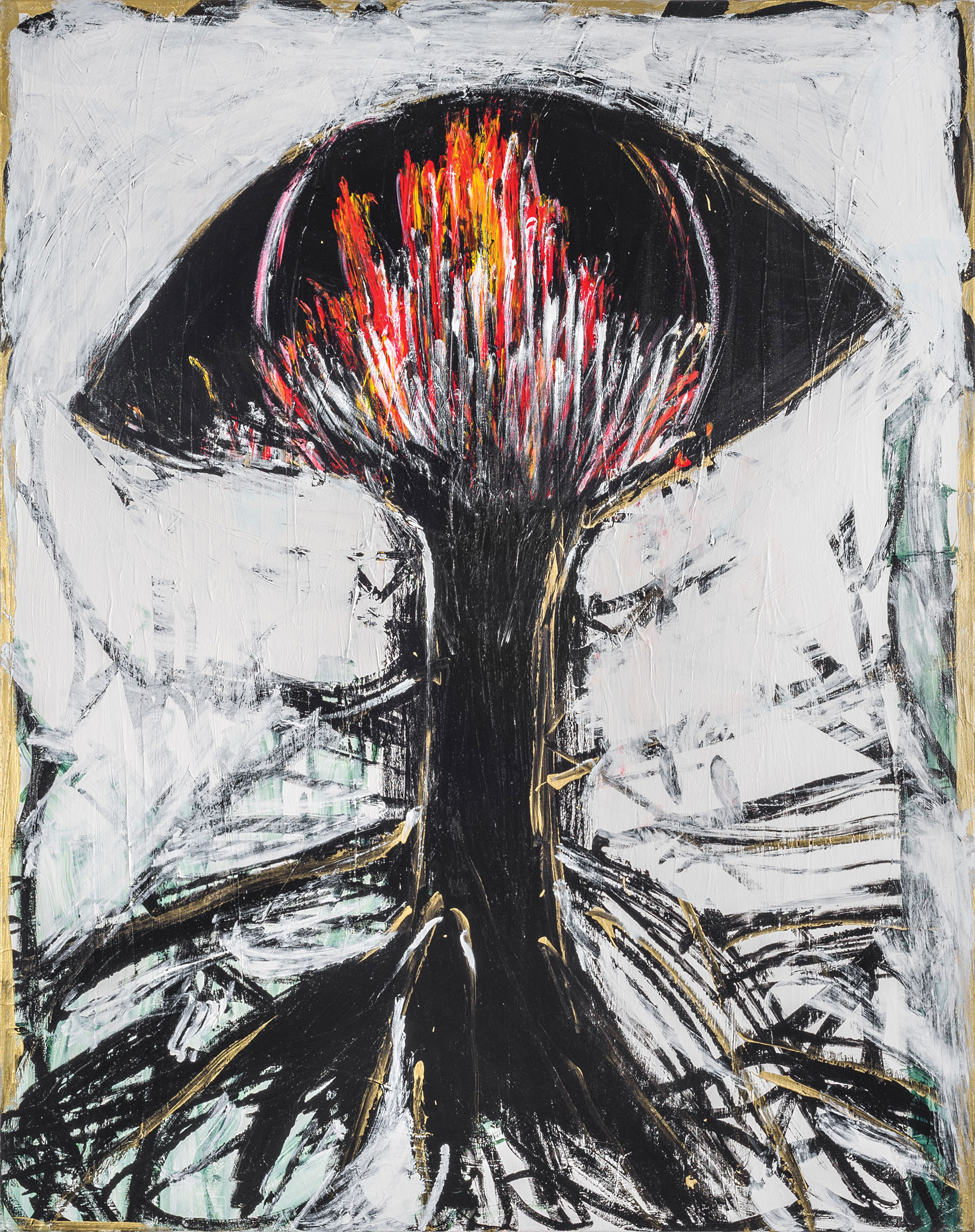
Hundreds of Miles of Pain, 2013, acrylic on canvas, 174x137
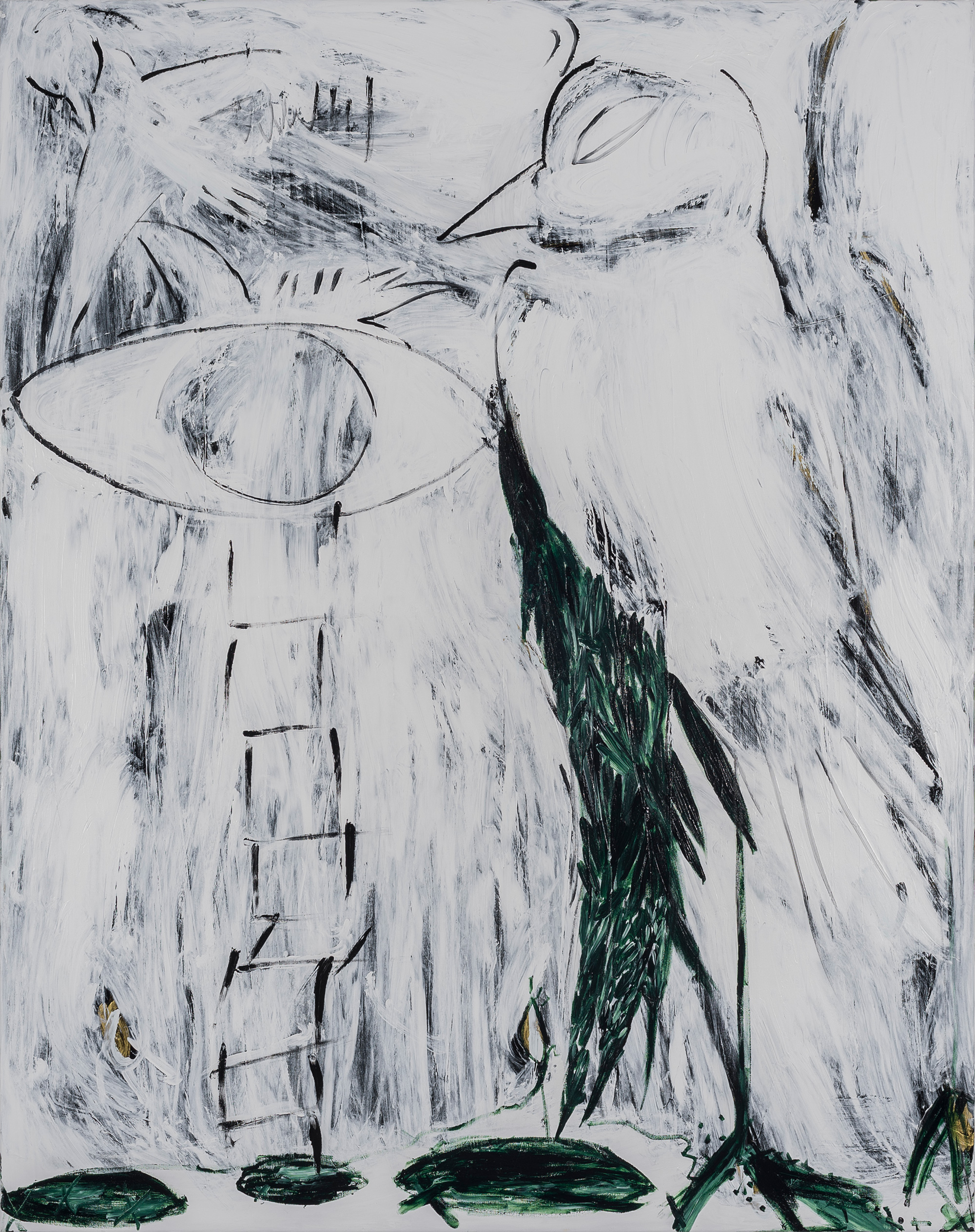
Song, Bird, 2013, acrylic on canvas, 174x137
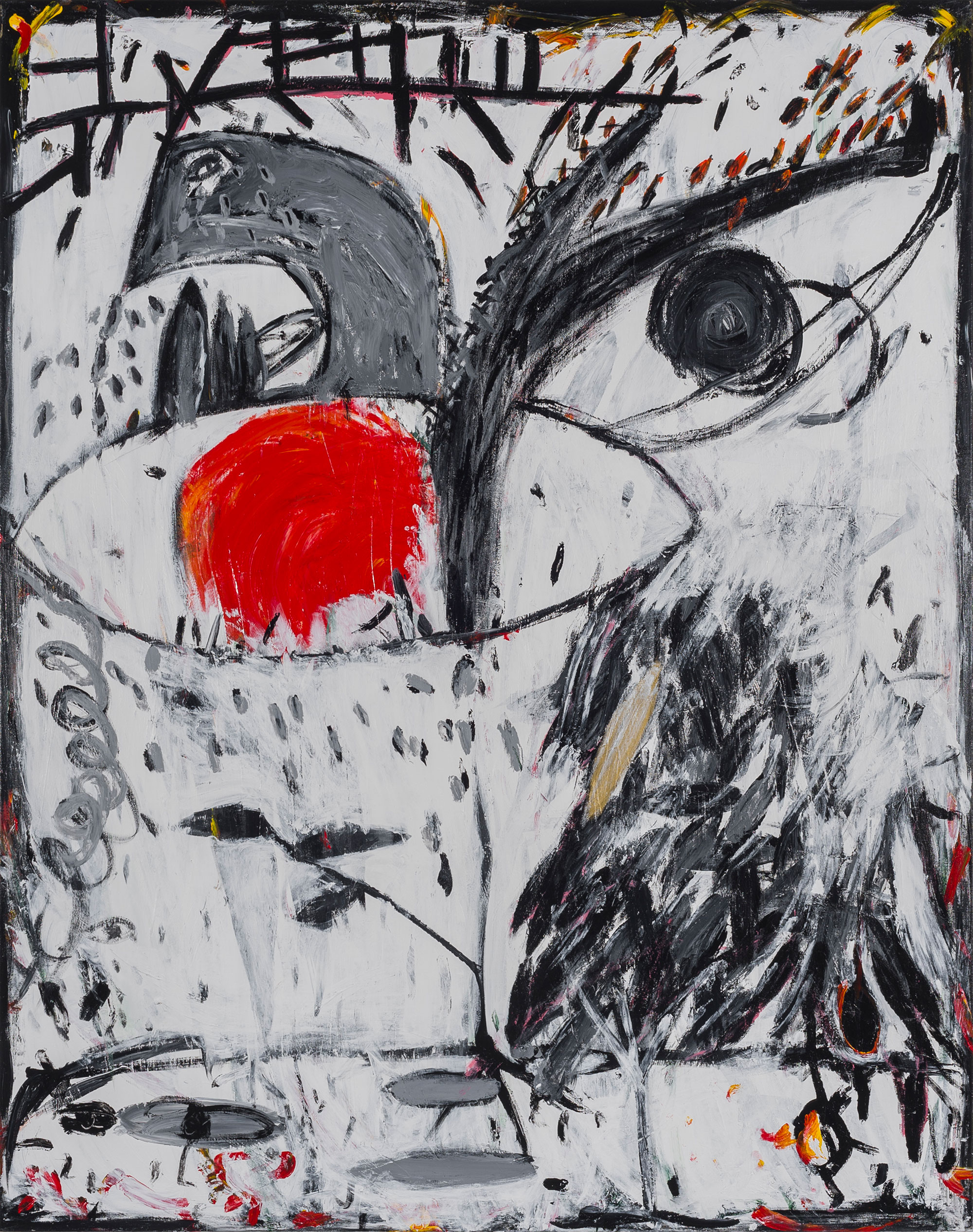
I was in Love Big Time, 2013, acrylic on canvas, 174x137

Her Heart is in the East, 2013, acrylic on canvas, 174x137
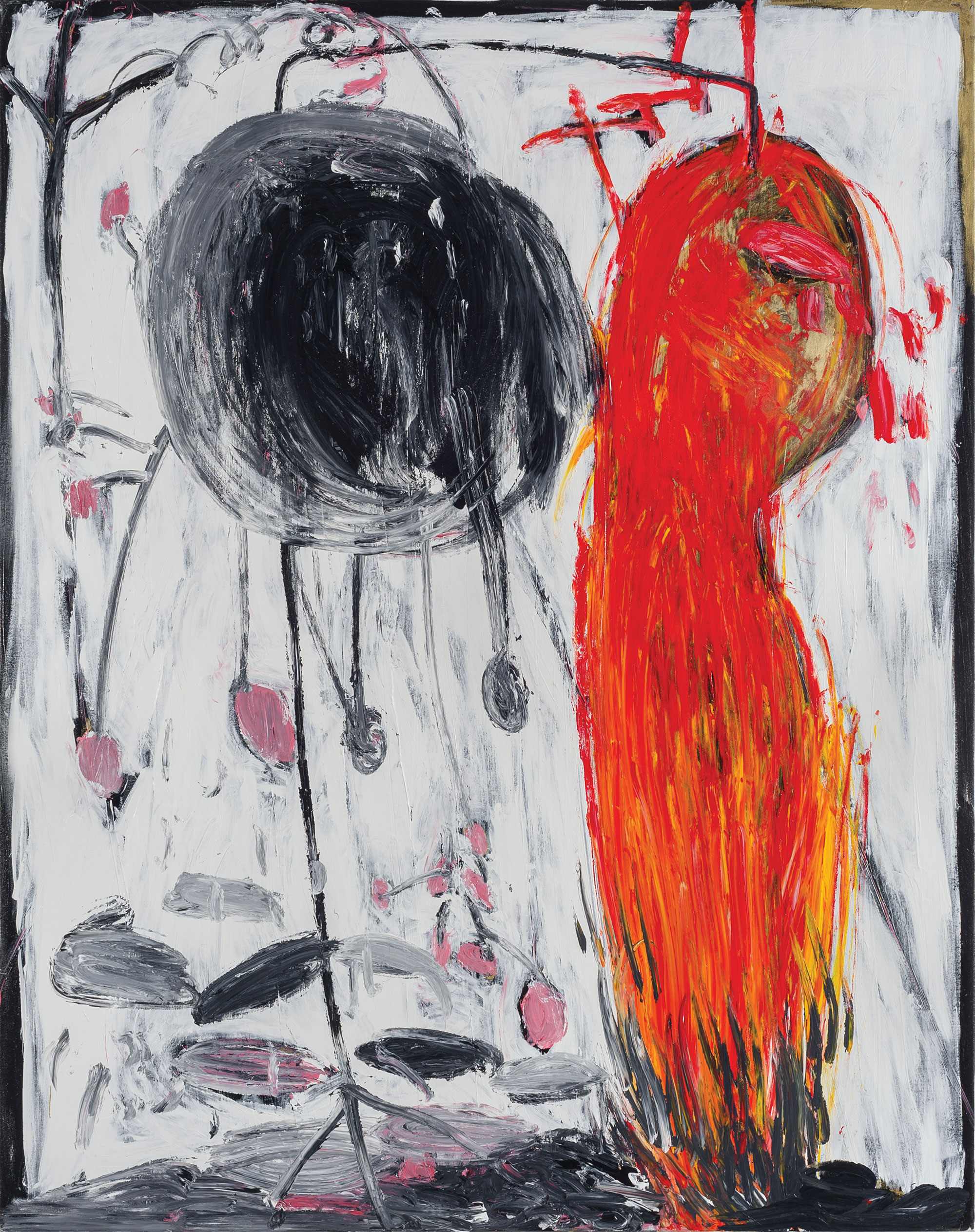
I Hope You Burn, 2013, acrylic on canvas, 174x137
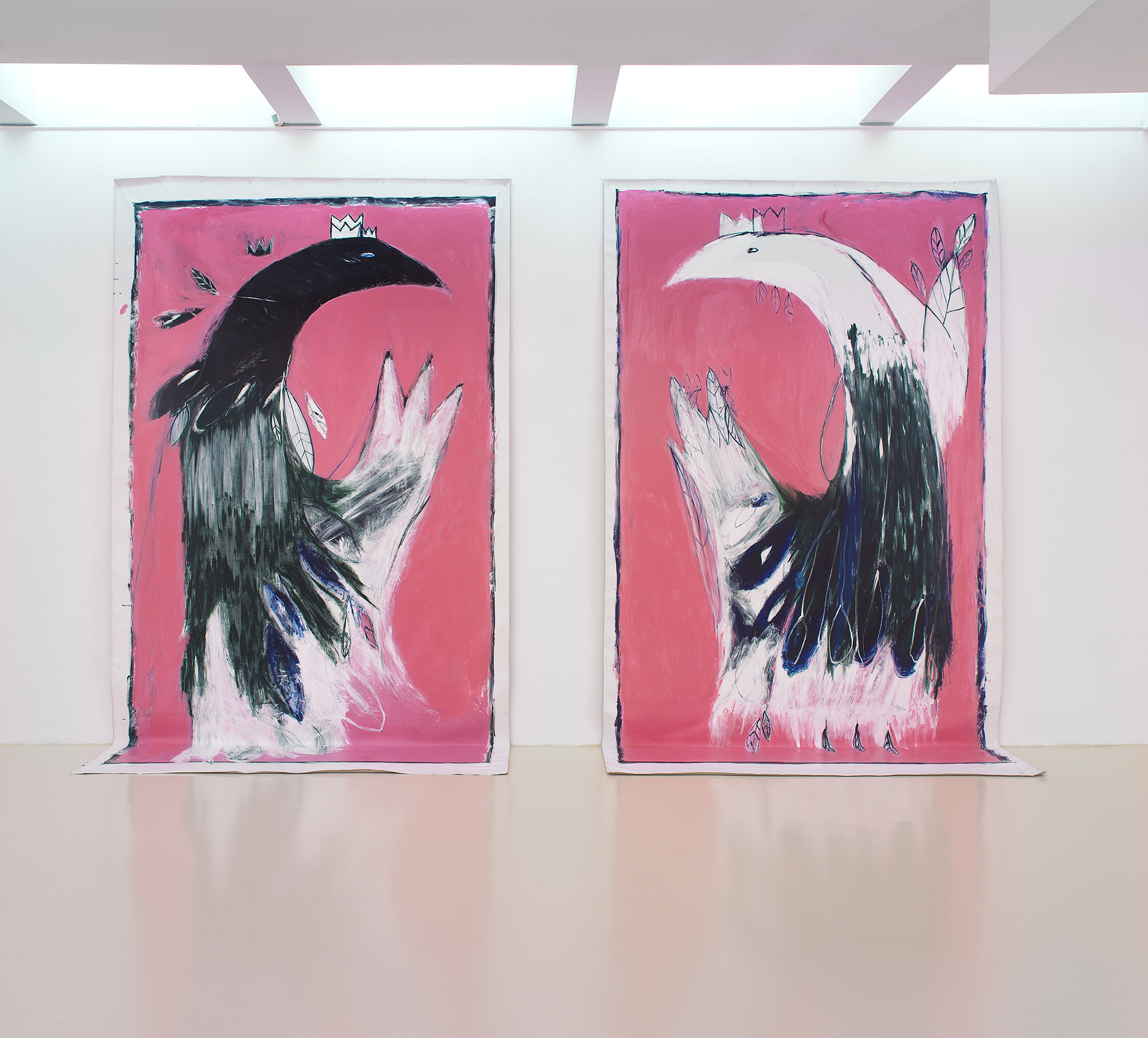
The Eagles, 2010, acrlic on canvas, 220x400(each)